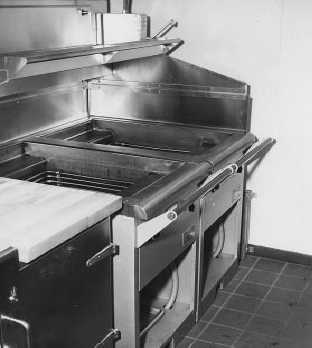| |
will flash on and off during the cooking process to
show the correct temperature is being maintained.
You are now ready to load the griddle.
4. Turn the griddle off or to the lowest
temperature setting during idle periods.
Care and Cleaning
Keep the cooking surface scraped and wiped
clean at all times. The grease gutters should always
be kept clean to help in draining off excess grease
and thereby reduce smoke. The grease receptacle
should be emptied frequently and thoroughly
cleaned at the end of the workday. Before starting
the griddle cleaning procedure, always make sure
the electrical power is turned off at the main power
panel and the correct tag-out procedures have been
followed. The cooking surface of most griddles can be
satisfactorily cleaned with a pumice stone. Never
use water. However, before cleaning, you should
read the manufacturer’s recommended cleaning
instructions for that particular griddle surface. After
each thorough cleaning, the griddle should be
seasoned. Seasoning is done by preheating the
griddle to 400°F. When the signal light goes off,
spread a light film of cooking oil or fat over the
entire surface of the griddle. In 2 minutes, wipe the
surface clean of excess oil. Repeat this operation.
The griddle is now ready for use.
TILTING SKILLET
Tilting skillets are large frying pans with deep
sides and an attached lid. They are used to grill, fry,
simmer, and braise large quantities of food. They
can be mounted on a wall or on a stand and can be
tilted at least 90 degrees from the normal horizontal
position for emptying cooked foods and cleaning.
Skillets are either gas or electric, have an electric
thermostat, and have a temperature range of 100°F
to 450°F. There is also a secondary thermostat that
is a high-limit cutoff that disables the power circuit
when the temperature exceeds 460°F. Gas skillets
are also furnished with a pressure regulator,
connector, quick-disconnect, and a 100-percent
shutoff device for the pilot (automatic ignition of
gas). Most skillets will also have a faucet directly
attached to the skillet to aid in cooking and cleaning.
Operation
The skillet is heated from the bottom by either
resistant heating elements or a series of gas
burners. Usually, the tilting mechanism can be
locked in any position. On some models, the tilting
feature may have a safety switch to be engaged if
the skillet is HOT or ON. If the skillet is provided
with a faucet, it may be connected directly to a
water supply.
NOTES:
(1) Keep the tilting mechanism
thoroughly lubricated for ease of
operation.
(2) Always turn off the heating
element before tilting.
Care in Cleaning
The tilting skillet should be cleaned after each
use. Before cleaning you must turn off the heating
element and scrape off the hardened food from the
inside of the skillet with a spatula or scraper and
flush down the sediment with a small amount of
water. If the skillet has become very dirty, fill it to
the level with hot water containing a mild hand-
dishwashing detergent. Turn on the heating
element and allow the water to come to a boil. Boil
the water for at least 5 to 10 minutes. Turn off the
heating element, drain, rinse with warm vinegar
water, then rinse thoroughly with clear water, and
dry the skillet well. Clean the outside of the skillet
with a grease-cutting detergent. Do not leave
heating element turned on when the skillet is
empty.
DEEP-FAT FRYER
Sizes of deep-fat fryers (fig. 4-3) are expressed in
the number of pounds of french fries that can be
cooked in an hour and range from 30 to 125
pounds. Some
48.11
Figure 4-3.—Deep-fat fryer.
4-4
|

